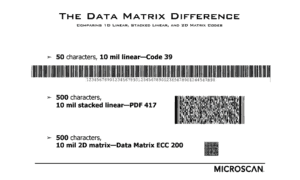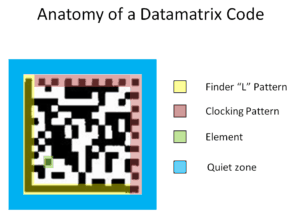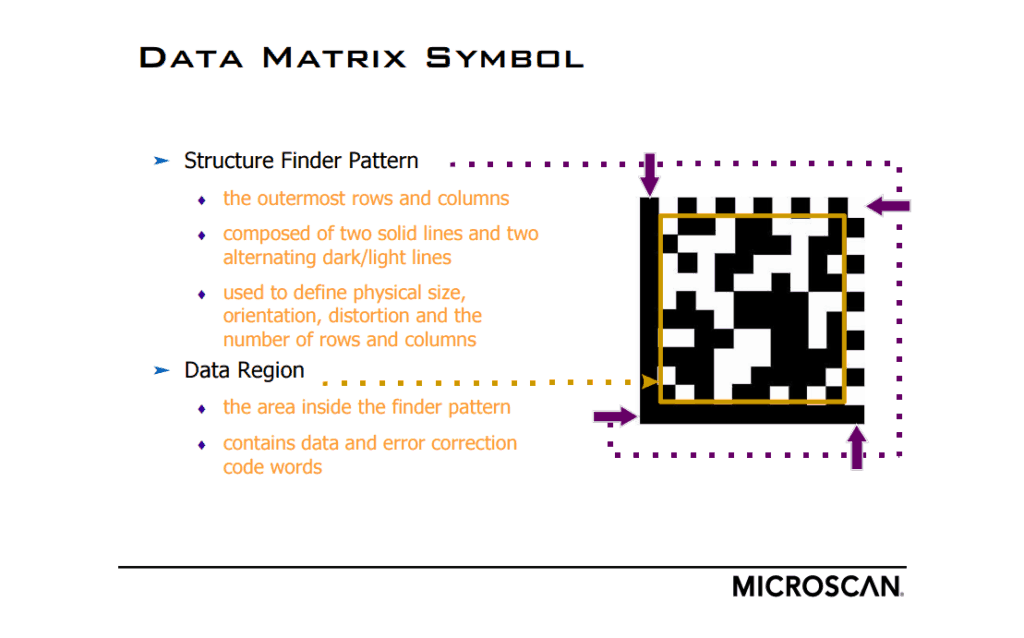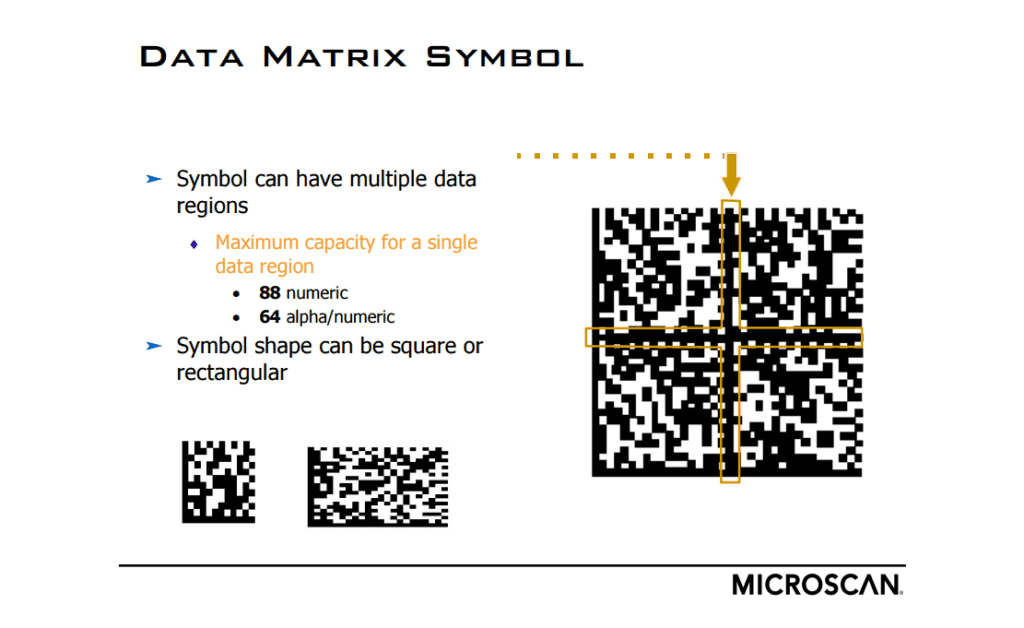With the emergence of the Internet of Things (IOT), choosing the type of barcode to use on your product can often be a daunting task. There are so many variables involved in barcode selection that, without intimate knowledge of the barcode symbology, choosing the correct barcode can be a challenge. While specific applications vary when it comes to selecting a barcode for manufacturing processes, the Datamatrix code is often the barcode of choice. Let’s take a look at what they are and how they’re used.
What are Datamatrix codes?

The History of 2D Codes
The Datamatrix code was invented by International Data Matrix, Inc. (ID Matrix), which was merged into RVSI/Acuity CiMatrix, who were acquired by Siemens AG in October 2005 and Microscan Systems in September 2008. Data Matrix is covered today by several ISO/IEC standards and is in the public domain for many applications, which means it can be used free of any licensing or royalties.
Elements of a Datamatrix Code

Datamatrix codes consist of four unique characteristics. They are:
- Modules – Modules are the black and white squares in the Datamatrix code that represent the data. Modules must be symmetrical. For example, if you print a 10 mil code, then each module must have a length of 10 mil’s on each side.
- Finder “L” pattern – The finder “L” pattern consists of the two solid lines on the outside of the Datamatrix code that form an “L” shape. This allows the barcode reader to orient the code so that it understands where to begin reading the pattern.
- Clocking pattern – The clocking pattern is used to inform the barcode reader about the number of modules in the matrix and is used to decode the grid on which the modules are placed.
- Quiet zone – All barcodes require a quiet zone. A quiet zone is an area outside of the barcode that is blank. Linear barcodes require a quiet zone at the beginning and end of the code that is 10 times the length of the narrowest element of the code. So if the narrow element is 20 mils, then you have to have 200 mils of quiet zone in order to properly read the code. By contrast, a Datamatrix code requires a quiet zone equal to the module size. If you print a 20 mil Datamatrix code, the requirement is 20 mil’s of blank space around the entire code. This allows for a much smaller footprint requirement which is often a critical concern in electronics manufacturing.


2D vs. Linear Barcodes

- Size/space limitations – 2D codes require much less physical space for the same amount of information, compared to a traditional linear barcode. For example, a 5 mil Datamatrix code with a capacity of 214 alphanumeric characters will fit into an area of .0086 square inches. If you put the same number of alphanumeric characters into a 5 mil, 3/8” high Code 39 linear barcode, it would require 5 separate barcodes to contain the data, with each barcode being 8 inches in length for a total of 75 square inches.
- Data size/density – The chart above provides an excellent illustration of the available Datamatrix code sizes and densities.
- Data integrity/error correction – A key advantage to using Datamatrix codes is the error correction capability inherent in the structure of the symbology. The developers of the data matrix code utilize the Reed-Solomon error correction method. This method is employed in many important applications, the most prominent of which include consumer technologies such as CDs, DVDs, and Blu-ray Discs. Using this method, Datamatrix codes can be decoded with up to 30% of the code missing. For those of you with an interest in code theory (and a major in mathematics!) this link contains an excellent paper that delves into the mathematics behind the Reed-Solomon process.
- Low contrast – Reading Datamatrix codes allow for reading at contrast levels as low as 20%. This provides the user with the ability to utilize barcode marking methods other than printing and applying label. Direct Part Marking (DPM) allows the permanent placement of a barcode on a part or product. The primary methods for DPM are dot peening or laser etching. While these methods do not approach the contrast levels of a black on white printed bar code, the beauty of the Datamatrix code is that it’s not necessary.

Datamatrix codes conform to the ISO/IEC 16022:2006 bar code symbology standard which defines all aspects of code construction. By adhering to this standard, Datamatrix codes can be consistently graded for quality on a range of parameters. Grading is on an A-F scale, with the lowest graded parameter being the total score. Users are allowed to set the grade that is acceptable to them, although most will not accept anything below a “B” grade, which ensures uniform readability across the majority of barcode reader manufacturers.
Reading the Code
Unlike linear barcodes, which generally rely on laser based scanners for decoding, Datamatrix codes are read by imagers. That is, the reader takes a picture of the code and then processes the data contained in the image. When decoding a Datamatrix, or any other 2D code, one must consider a few more factors that are normally associated with decoding linear barcodes.
- Distance considerations – Imagers usually require that the barcode is in close proximity to the lens. Distances are generally in the 2-12” range (special lensing can increase this range, but is not common), while some linear barcode scanners can accurately decode at ranges up to 120”.
- Speed considerations – Because of the large amount of information to be processed, imagers cannot decode at the same rates that linear barcode scanners are capable of. However, it is possible to use imagers to accurately decode Datamatrix codes that are traveling in excess of 100 inches per second.
- External lighting – While most imagers contain internal light sources to illuminate the barcode, these may be inadequate to the task at hand due to a myriad of issues including extremely low contrast, specular reflection, or high speed applications that require a large amount of light to compensate for high shutter speeds that are necessary to reduce image blur.
Conclusion
Datamatrix codes offer users high data capacity, small size, and a variety of cost effective labeling options. Cross has extensive experience in the application and reading of Datamatrix codes. If you are considering using Datamatrix codes in your manufacturing process, give us a call. We’re here to help!
